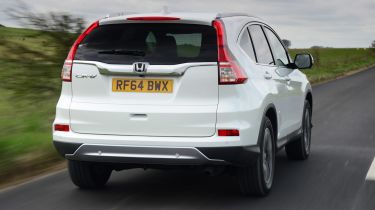Used Honda CR-V (Mk4, 2012-2017) review - How much will it cost?
It’ll cost a little more to buy, but the Honda rewards with low running costs and strong residuals
The Honda costs more to buy than rivals, but you do get a lot of car for your money, both in terms of space and equipment. It also won’t break the bank to run thanks to its efficient engines, plus strong reliability that’ll keep repair bills to a minimum.
Prices
Honda models traditionally hold onto their value well, and the CR-V continues this trend. Excellent practicality, strong reliability and relatively limited choice means that demand for used examples is strong and prices are typically higher than many mainstream rivals.
While that’s bad news when you’re buying, it does mean you’ll get back more of your outlay when you sell. Diesels are the most popular, so if you’re looking to get a lot of CR-V for the least amount of cash possible, then seek out one of the rarer petrol versions.
You can check out the latest used prices for the Honda CR-V Mk4 by checking out the live used listings on our Find a Car service, or by using our free car valuation tool for prices on a specific car.
Fuel economy and CO2 emissions
Despite its large exterior dimensions the CR-V is a surprisingly frugal machine, especially the 1.6 i-DTEC engine. The lower-powered 118bhp version claims 64.2mpg, as well as 115g/km emissions.
Used - available now
The more powerful 158bhp i-DTEC diesel is still impressive, with a claimed 57.7mpg and 125g/km in SE manual guise. Fit the automatic gearbox, and the official economy figures will plummet by around 2mpg, while emissions will rise by 5-6g/km. Plus, higher trim levels with bigger alloy wheels mildly affect efficiency, too.
Not surprisingly, the 2.0-litre i-VTEC petrol CR-V is less frugal. Manual front-wheel-drive versions claim 39.2mpg economy and 168g/km emissions, while cars specified with an automatic gearbox and 4x4 transmission have official figures as low as 36.7mpg and as high as 179g/km. So while the diesels sit in road tax bands C to E, the petrol CR-Vs fall into band H or I, and will cost you more in road tax.
Earlier cars fitted with the larger 148bhp 2.2-litre i-DTEC diesel aren’t quite as efficient, although that’s hardly surprising given the larger size of the engine. Still, a claimed return of 48.7mpg and CO2 emissions of 154g/km are very respectable for such a big car with standard four-wheel drive.
Running costs
The service interval on all CR-Vs is set at 12 months or 12,500 miles. Maintenance alternates between minor and major services. Petrol-engined cars the prices are pegged at £205 and £315 respectively; for diesels the equivalent costs are £225 and £350.
All engines are chain-driven, so there are no cambelts to replace. The coolant needs to be checked at each service, and any fluid replacement is covered within the cost of the check-up. The brake fluid, meanwhile, should be replaced every other year at an additional cost.
The standard manufacturer’s warranty is three years or 90,000 miles, whichever comes sooner, which means even the newest examples will just miss out on manufacturer guarantee. On the plus side, Honda provides five years’ worth of exhaust corrosion cover, 10 years for chassis corrosion and 12 years for structural corrosion, which can be transferred to a new honour. Honda also offered an extended warranty for years four and five, so it’s worth checking whether any prospective purchase is covered.
The petrol models are cheaper to insure than the diesels, with the S and SE-spec CR-Vs sitting in group 22, and the SR and EX range-toppers in group 23. For the diesels, opting for four-wheel drive has a negative impact on the cost of insurance. All the two-wheel-drive variants are in groups 22 and 23, like the petrols, but specifying 4WD sees the CR-V placed in groups 26 and 27.











